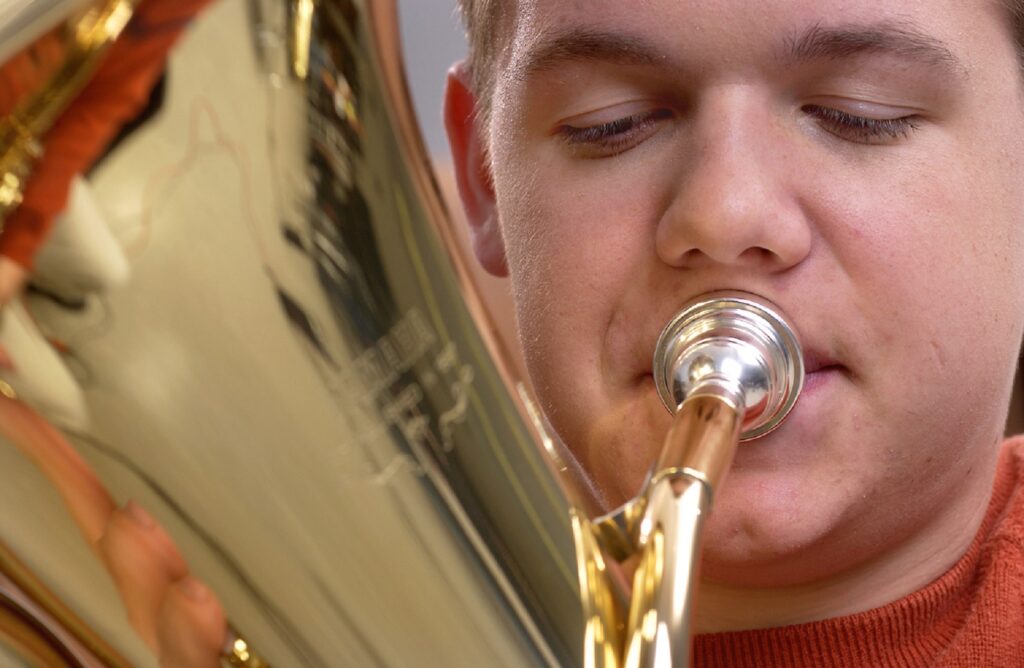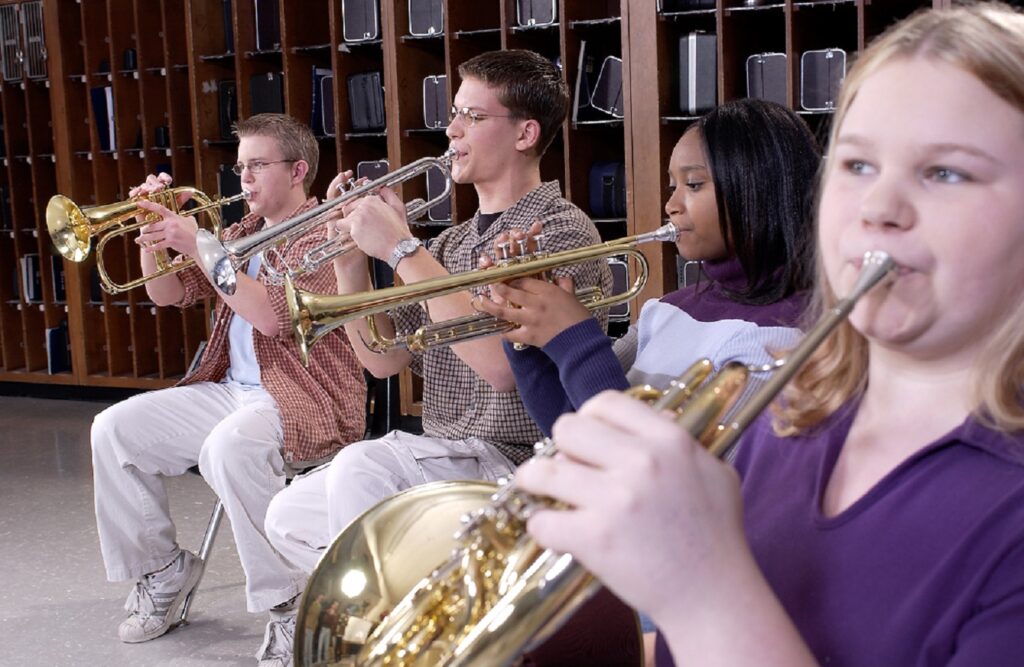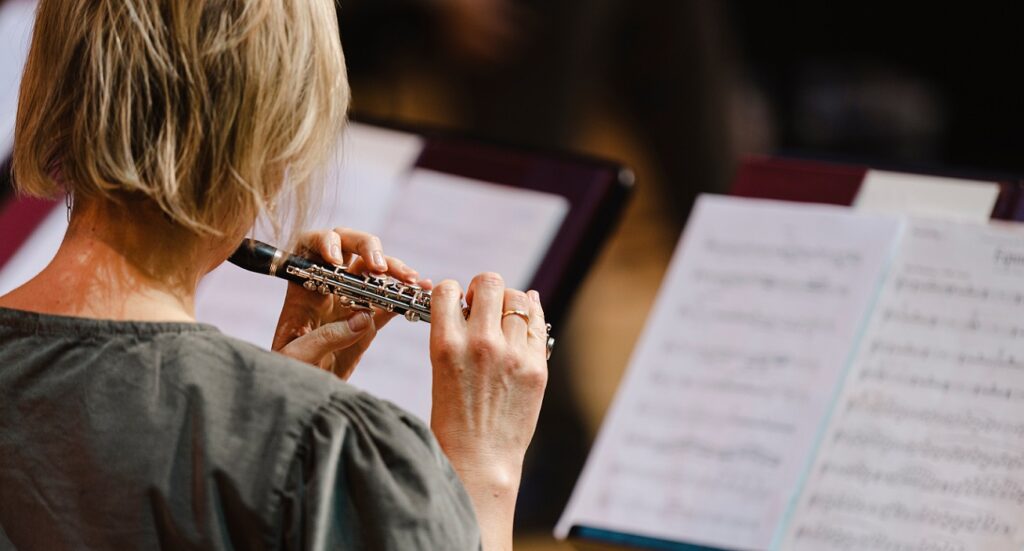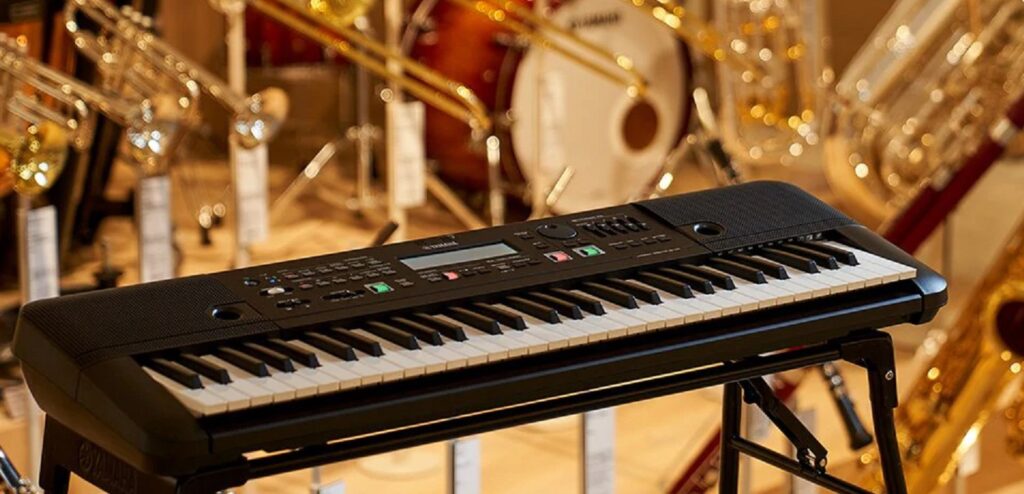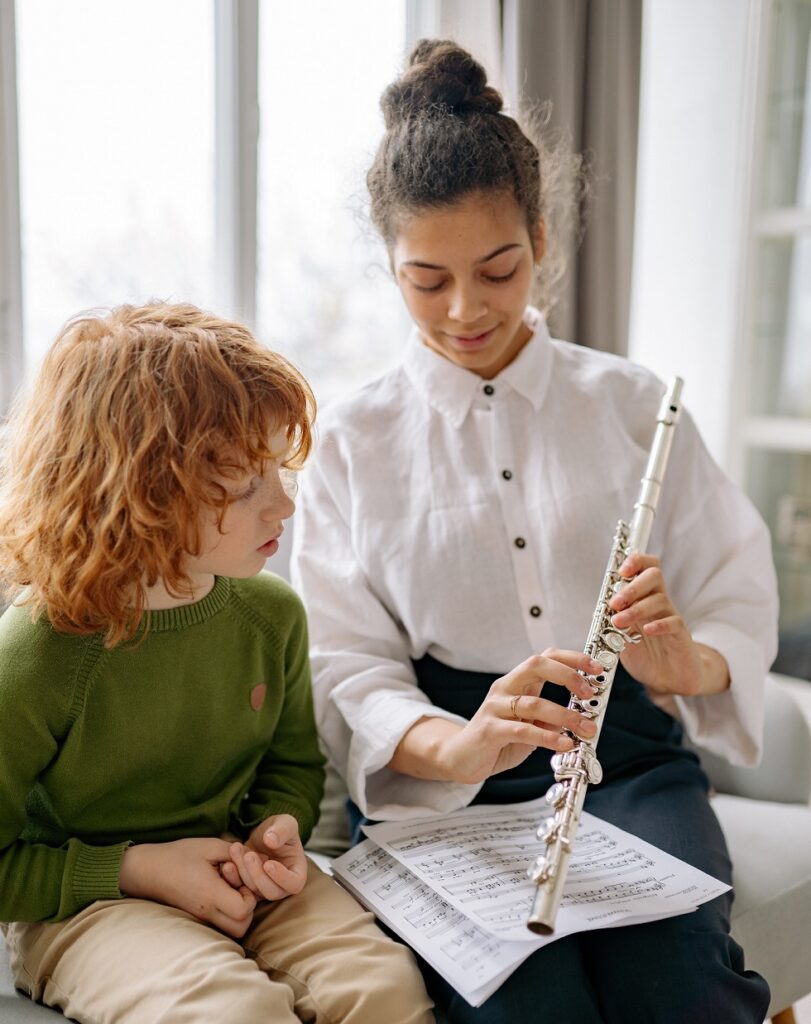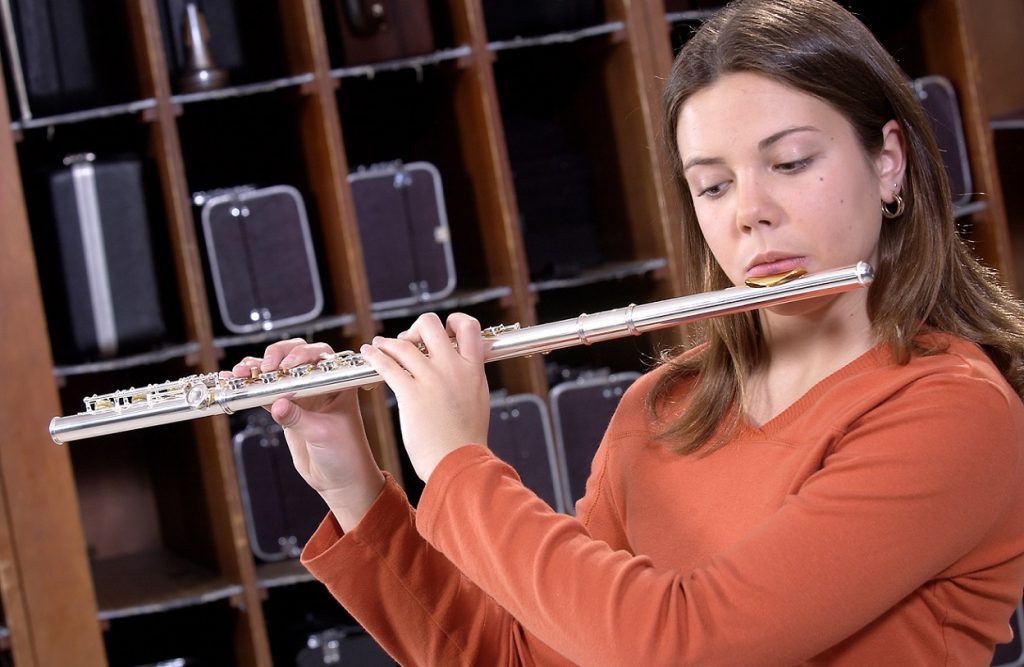Set Up Your First-Year Flutes for Success
Help your beginning flute players with their embouchures, posture, note-bending, intentional listening and more.
It can be challenging to teach an instrument like the flute if it isn’t your primary instrument. Here are some tips to set up your first-year flutes for success, even if you don’t play the flute very often. But first, let’s tackle the obvious question: Why is the flute so difficult for those who are just getting started?
Common Challenges for Beginning Flutists
- The flute is long and awkward to hold.
- There’s no reed, so minor changes in air direction make a gargantuan difference in your sound.
- The flute requires more air than a euphonium or tuba.
No other band instrument is held sideways. The flute is a “partially blind instrument,” which means that you can’t see your fingers when you’re playing it. This is the opposite of a piano, for example, where you can see all the keys all the time.
 Holding a flute correctly can be tiring, but holding it incorrectly causes a host of problems, including poor tone and muscle strains or sprains. Flutists are especially prone to neck pain and carpal tunnel, so it is imperative to keep an eye on their posture. Be sure that your flutists sit up straight and curve their wrists into a “C” position. Flutists should not lean their heads to the right (toward the flute).
Holding a flute correctly can be tiring, but holding it incorrectly causes a host of problems, including poor tone and muscle strains or sprains. Flutists are especially prone to neck pain and carpal tunnel, so it is imperative to keep an eye on their posture. Be sure that your flutists sit up straight and curve their wrists into a “C” position. Flutists should not lean their heads to the right (toward the flute).
The lack of a reed means that a millimeter’s worth of change on the flute can be huge. Flutists are often easily frustrated with how the flute responds one moment, and not at all (nothing but air) the next. Because the flute is blown across, two-thirds of the air you put out goes around and across the instrument instead of inside. This means that it takes far more air to make a sound on the flute than it does a tuba.
On top of this, the flute tends to favor those with symmetrical lips. That being said, here are some tips and tricks on how to create different embouchures for people with asymmetrical lips. But my main message is: Don’t fret. Anyone can learn to play the flute.
THE 400/300/200 SERIES FLUTES: Help your beginning flutist choose their ideal first instrument!
Take Time with the Headjoint
Many method books, such as the Essential Elements series, start flutists on the headjoint. This is a great first step, but many directors don’t spend enough time on it. Even in beginning flute books, the headjoint how-to section is too brief, so most folks don’t linger on it.
However, it is essential to work on the headjoint for longer than you think. Be sure to have your students practice high and low partials to home in on making a solid sound. Other things you can try in order to practice different embouchures on the headjoint are covering the headjoint (to help students find and play a lower pitch), bending the note up and down (to help get a focused sound) and articulating different rhythms in order to make sure students are tonguing correctly. I like to use clapping exercises to help with rhythms.
Don’t Get Technical Too Soon
It’s difficult to get a steady sound on the flute when you are getting started, so don’t get into quick passages too soon. If you want to work on band pieces with faster notes, have a flute section where you slow it down and do some tone exercises that focus on transitioning to these notes in a sequence before you put it all together in rehearsal. To really home in on each note, have students practice the passage with each note as a quarter note at the rate of 60 bpm. I use this technique in my own daily practice to set muscle memory in both my fingers and embouchure.
Hire a Part-Time Flute Sectional Instructor
If you aren’t a virtuosic flutist, hire a part-time sectional instructor to save you a lot of headaches. Contact a flute major at a local college, a member of a local orchestra or community band, or even alumni from the school you teach at. Sectional instructors who are experts on their instrument will benefit the entire band, but I believe them to be most essential for flutists, double reed players and French horn players. These are the traits I look for in a sectional instructor:
- Experience
- Accountability
- Relatability / Sense of Humor
- Confidence
Finding players with experience is important, but they also need to be able to connect to your students when you’re not in the room. Sectional instructors can introduce your students to new solo pieces and duets and get them practicing their instrument in a new context. Plus, if this instructor is available in the summer, they can also help your woodwinds at band camp if you teach at the high school level.
Another essential facet to hiring a sectional instructor is the logistics. In order to get approval, prepare to talk to your administration about the hiring process, including hourly rates and background checks. Be sure to schedule at least one formal interview per qualified candidate and bring along another licensed teacher from your district to get a second opinion.
Start Class with Intentional Listening
Pupils are sponges and learn from repetition. A large part of becoming a rich and strong flute player is to watch professional musicians like Jean-Pierre Rampal, Emmanuel Pahud, William Bennett and Denis Bouriakov. My college flute professor told me to also listen to vocalists like Maria Callas to help me get a vocal quality to my playing.
When I taught instrumentalists in a large group setting, I would rotate the different types of instrumental solos to expose my students to professional playing without taking too much time from their playing. Segments of the following instructional videos and pieces will go a long way:
- Rampal on Articulation
- Bouriakov’s Carmen Fantasy / Encore Version
- Pahud’s Fantaisie
- Bennett’s Mel Bonis Sonata
Blowing Down, Note Bending and Long Tones
While many band directors believe you should encourage students to blow across the flute, I think it is more helpful to tell students to blow down in the direction of their lap. While blowing across the tone hole will produce a sound, it is often a tone that has out-of-tune harmonics and lacks consistency. Also, blowing straight across sounds airy, and the note usually phases in and out. Blowing down and rolling in the headjoint to an extreme can cause the pitch to be flat, so when you start blowing down more, you will need to push in your headjoint to compensate.
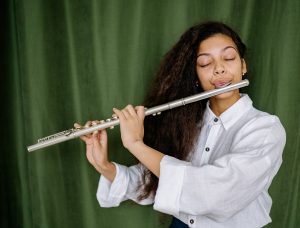 Another thing that is somewhat related to blowing down is note bending. This is a practice that flutist William Bennett swore by. He encouraged young flutists to bend the pitch of their note both up and down while they practiced long tones. This will help students strengthen their embouchure muscles, familiarize them with their instrument and find their tonal center.
Another thing that is somewhat related to blowing down is note bending. This is a practice that flutist William Bennett swore by. He encouraged young flutists to bend the pitch of their note both up and down while they practiced long tones. This will help students strengthen their embouchure muscles, familiarize them with their instrument and find their tonal center.
Note bending is not the same thing as blowing down. It can be done in a variety of ways. You can roll the headjoint in as you play (to make the pitch flatter) or roll it out (to make the pitch sharper). You can also tighter and loosen your corners or change the direction or velocity of your air. Overblowing will lead to a higher pitch, while underblowing will lead to a lower one. The goal of note bending is to explore the instrument, and a way to alter pitch that best works for you. In the long run, note bending will help you control your tone and wrangle out-of-tune notes into something beautiful. Blowing down, on the other hand, only aids in producing a better tone. It doesn’t help you get to know the ins and outs of the flute as much as note bending does.
It’s worth nothing that note bending doesn’t have to be done in isolation. Brass players and other woodwinds will find this exercise helpful, too. Brass players can use their corners to manipulate their pitch or make the size of the space inside their mouths smaller. The exact method of note bending varies on each instrument, which is again, why sectionals can be valuable.
Help Students Find What’s Comfortable for Them
Posture and embouchure are essential for flute players. Pupils often wonder if they should raise their flute higher. Or, how they can give their arm a break while still producing a good sound.
The most important tip to set up your first-year flutes for success is to help them find what is comfortable for them. Ask guiding questions about tone, such as: “I heard you produce a richer sound in that passage. How did you change the way you played your instrument in order to get that sound?” When flutists can self-reflect during practice, they will be more likely to experiment with embouchure and position.
I hold my arms at a lower, more relaxed position. Standard marching band posture will have flutists holding their instrument parallel, for aesthetic reasons. I find that a slight angle down is best for concert band and solo playing. Principal flutist Joel Tse of the Toledo Symphony also plays with his arms angled down slightly. I believe this position to be more ergonomic.
Some teachers insist that your embouchure must be centered, but this simply doesn’t work for students with a cupid’s bow or teardrop in the lip, which can cause the air to split into two streams, making it difficult to focus and control your sound. To solve this, you can play with an embouchure that pulls to the left. This is what is referred to as an “offset embouchure.” Bouriakov (the principal flutist of the Los Angeles Philharmonic) uses this embouchure, and so do I.
One way to tell if a flutist is getting a good sound is when the condensation on the lip plate is triangle-shaped. Encouraging students to practice with a mirror allows them to see for themselves if that triangle is present. By watching themselves in mirrors, students can notice large shifts in their embouchures and will begin to narrow those large lip shifts down into small, controlled movements that hit the target of each note in a way that works for them.
Flutists must be given the time to explore their instrument and determine what is safe and comfortable for their bodies!












